Doss - Study guides, Class notes & Summaries
Looking for the best study guides, study notes and summaries about Doss? On this page you'll find 91 study documents about Doss.
Page 4 out of 91 results
Sort by
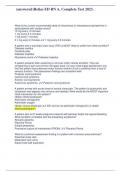
-
Relias ED RN A, Complete Test Fall 2023 What is the current recommended dose of intravenous or intraosseous epinephrine in adult patients with cardiac arrest? 10 mg every 10 minutes 1 mg every 3-5 minutes 1 mg every 7 minutes 0.1 mg every 2 minutes A pati
- Exam (elaborations) • 22 pages • 2023
-
- $13.99
- + learn more
Relias ED RN A, Complete Test Fall 2023 What is the current recommended dose of intravenous or intraosseous epinephrine in adult patients with cardiac arrest? 10 mg every 10 minutes 1 mg every 3-5 minutes 1 mg every 7 minutes 0.1 mg every 2 minutes A patient with a traumatic brain injury (TBI) is MOST likely to suffer from what condition? Diabetes mellitus Cerebral palsy Diabetes Insipidus Myxedema coma A patient presents after sustaining a roll-over motor vehicle accident. They are complaining ...
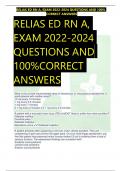
-
RELIAS ED RN A, EXAM 2022-2024 QUESTIONS AND 100%CORRECT ANSWERS What is the current recommended dose of intravenous or intraosseous epinephrine in adult patients with cardiac arrest? 10 mg every 10 minutes 1 mg every 3-5 minutes 1 mg ever
- Exam (elaborations) • 23 pages • 2023
-
- $23.99
- + learn more
RELIAS ED RN A, EXAM 2022-2024 QUESTIONS AND 100%CORRECT ANSWERS What is the current recommended dose of intravenous or intraosseous epinephrine in adult patients with cardiac arrest? 10 mg every 10 minutes 1 mg every 3-5 minutes 1 mg every 7 minutes 0.1 mg every 2 minutes 1 mg every 3-5 minutes A patient with a traumatic brain injury (TBI) is MOST likely to suffer from what condition? Diabetes mellitus Cerebral palsy Diabetes Insipidus Myxedema coma...
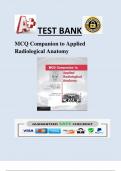
-
MCQ Companion to Applied Radiological Anatomy
- Exam (elaborations) • 216 pages • 2024
-
- $16.99
- + learn more
c G U v s t ss Cambridge, New York, Melbourne, Madrid, Cape Town, Singapore, São Paulo Cambridge University Press The Edinburgh Building, Cambridge c 2 2 U, United Kingdom Published in the United States by Cambridge University Press, New York Information on this title: © A. Doss, M.J. Bull, A. Sprigg & P.D. Griffiths 2003 This book is in copyright. Subject to statutory exception and to the provision of relevant collective licensing agreements, no reproduction of any part may take pla...
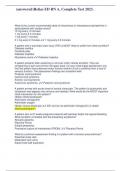
-
(answered)Relias ED RN A, Complete Test 2023. What is the current recommended dose of intravenous or intraosseous epinephrine in adult patients with cardiac arrest? 10 mg every 10 minutes 1 mg every 3-5 minutes 1 mg every 7 minutes 0.1 mg every 2 minutes
- Exam (elaborations) • 22 pages • 2023
-
- $27.99
- + learn more
(answered)Relias ED RN A, Complete Test 2023. What is the current recommended dose of intravenous or intraosseous epinephrine in adult patients with cardiac arrest? 10 mg every 10 minutes 1 mg every 3-5 minutes 1 mg every 7 minutes 0.1 mg every 2 minutes 1 mg every 3-5 minutes A patient with a traumatic brain injury (TBI) is MOST likely to suffer from what condition? Diabetes mellitus Cerebral palsy Diabetes Insipidus Myxedema coma Diabetes Insipidus A patient presents after sustaining a roll...
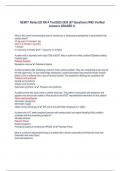
-
NEW!!! Relias ED RN A Test2023-2024 (67 Questions) With Verified Answers GRADED A What is the current recommended dose of intravenous or intraosseous epinephrine in adult patients with cardiac arrest? 10 mg every 10 minutes 1 mg every 3-5 minutes 1 mg eve
- Exam (elaborations) • 20 pages • 2023
-
- $17.99
- + learn more
NEW!!! Relias ED RN A Test (67 Questions) With Verified Answers GRADED A What is the current recommended dose of intravenous or intraosseous epinephrine in adult patients with cardiac arrest? 10 mg every 10 minutes 1 mg every 3-5 minutes 1 mg every 7 minutes 0.1 mg every 2 minutes 1 mg every 3-5 minutes A patient with a traumatic brain injury (TBI) is MOST likely to suffer from what condition? Diabetes mellitus Cerebral palsy Diabetes Insipidus Myxedema coma Diabetes Insipidus A patient pre...
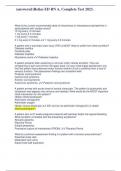
-
Relias ED RN A, Complete Test Fall 2023 What is the current recommended dose of intravenous or intraosseous epinephrine in adult patients with cardiac arrest? 10 mg every 10 minutes 1 mg every 3-5 minutes 1 mg every 7 minutes 0.1 mg every 2 minutes A pati
- Exam (elaborations) • 22 pages • 2023
-
Available in package deal
-
- $15.99
- + learn more
Relias ED RN A, Complete Test Fall 2023 What is the current recommended dose of intravenous or intraosseous epinephrine in adult patients with cardiac arrest? 10 mg every 10 minutes 1 mg every 3-5 minutes 1 mg every 7 minutes 0.1 mg every 2 minutes A patient with a traumatic brain injury (TBI) is MOST likely to suffer from what condition? Diabetes mellitus Cerebral palsy Diabetes Insipidus Myxedema coma A patient presents after sustaining a roll-over motor vehicle accident. They are complaining ...

-
RELIAS ED RN A, EXAM 2022-2024 QUESTIONS AND 100%CORRECT ANSWERS What is the current recommended dose of intravenous or intraosseous epinephrine in adult patients with cardiac arrest? 10 mg every 10 minutes 1 mg every 3-5 minutes 1 mg every 7 minutes 0.1
- Exam (elaborations) • 23 pages • 2023
-
- $18.99
- + learn more
RELIAS ED RN A, EXAM 2022-2024 QUESTIONS AND 100%CORRECT ANSWERS What is the current recommended dose of intravenous or intraosseous epinephrine in adult patients with cardiac arrest? 10 mg every 10 minutes 1 mg every 3-5 minutes 1 mg every 7 minutes 0.1 mg every 2 minutes 1 mg every 3-5 minutes A patient with a traumatic brain injury (TBI) is MOST likely to suffer from what condition? Diabetes mellitus Cerebral palsy Diabetes Insipidus Myxedema coma Diabetes Insipidus A patien...
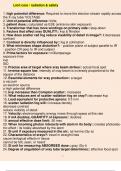
-
Lmrt core / radiation & safety 1. high potential difference: Required to move the electron stream rapidly across the X-ray tube/ VOLTAGE 2. Unit of potential difference: Volts 3. patient dose:: calculated as ESE (entrance skin exposure) 4. Transformer tha
- Exam (elaborations) • 2 pages • 2023
-
- $10.49
- + learn more
Lmrt core / radiation & safety 1. high potential difference: Required to move the electron stream rapidly across the X-ray tube/ VOLTAGE 2. Unit of potential difference: Volts 3. patient dose:: calculated as ESE (entrance skin exposure) 4. Transformer that has more windings on primary side:: step-down 5. Factors that affect xray QUALITY:: kvp & filtration 6. How does scatter rad fog reduce visability of detail in image?: it decreases contrast 7. Contrast is directly influenced by:: fog ...
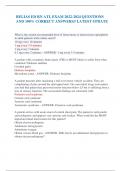
-
RELIAS ED RN ATI, EXAM 2022-2024 QUESTIONS AND 100% CORRECT ANSWERS// LATEST UPDATE What is the current recommended dose of intravenous or intraosseous epinephrine in adult patients with cardiac arrest?
- Exam (elaborations) • 26 pages • 2024
- Available in package deal
-
- $30.49
- + learn more
RELIAS ED RN ATI, EXAM QUESTIONS AND 100% CORRECT ANSWERS// LATEST UPDATE What is the current recommended dose of intravenous or intraosseous epinephrine in adult patients with cardiac arrest? RELIAS ED RN ATI, EXAM QUESTIONS AND 100% CORRECT ANSWERS// LATEST UPDATE What is the current recommended dose of intravenous or intraosseous epinephrine in adult patients with cardiac arrest? RELIAS ED RN ATI, EXAM QUESTIONS AND 100% CORRECT ANSWERS// LATEST UPDATE What is the current ...
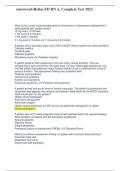
-
Relias ED RN A, Complete Test Fall 2023 What is the current recommended dose of intravenous or intraosseous epinephrine in adult patients with cardiac arrest? 10 mg every 10 minutes 1 mg every 3-5 minutes 1 mg every 7 minutes 0.1 mg every 2 minutes A pati
- Exam (elaborations) • 22 pages • 2023
-
Available in package deal
-
- $13.99
- + learn more
Relias ED RN A, Complete Test Fall 2023 What is the current recommended dose of intravenous or intraosseous epinephrine in adult patients with cardiac arrest? 10 mg every 10 minutes 1 mg every 3-5 minutes 1 mg every 7 minutes 0.1 mg every 2 minutes A patient with a traumatic brain injury (TBI) is MOST likely to suffer from what condition? Diabetes mellitus Cerebral palsy Diabetes Insipidus Myxedema coma A patient presents after sustaining a roll-over motor vehicle accident. They are complaining ...

Do you wonder why so many students wear nice clothes, have money to spare and enjoy tons of free time? Well, they sell on Stuvia! Imagine your study notes being downloaded a dozen times for $15 each. Every. Single. Day. Discover all about earning on Stuvia


